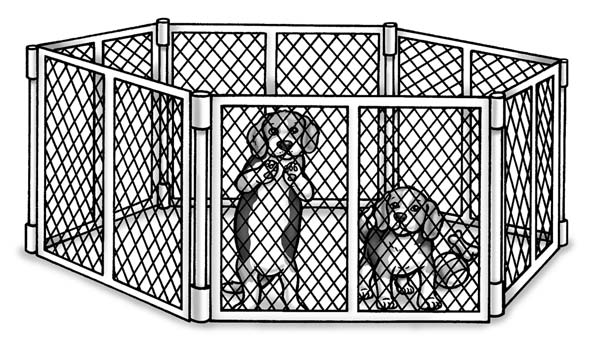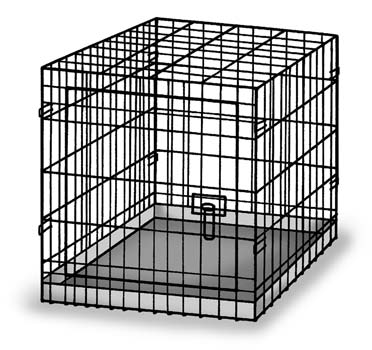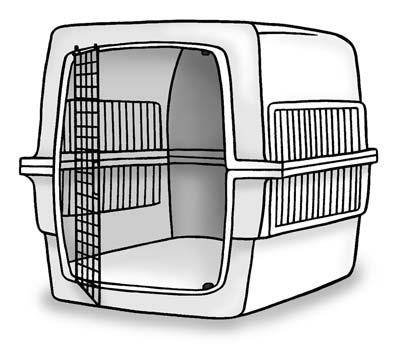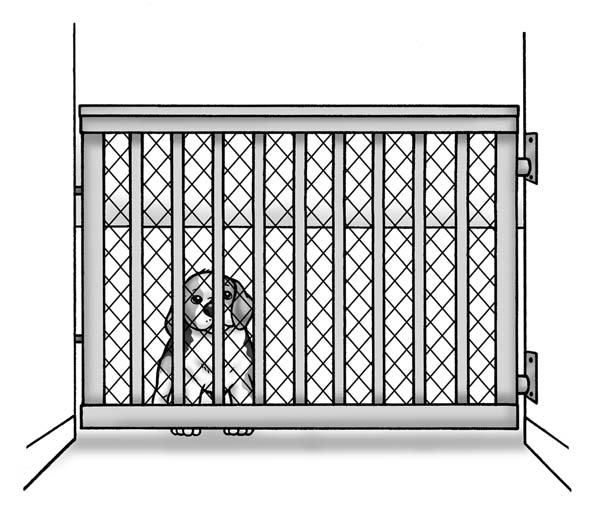- Selecting a veterinarian
- Getting gear for your Beagle
- Making your house Beagle-ready
- Planning for your Beagle’s first day home
Choosing the Beagle of your dreams involves much more than heading to a reputable breeder, a local animal shelter, or a breed rescue group. Before you start life with your new four-legged friend, you need to prepare yourself and your home for his arrival. This chapter tells you how to accomplish both tasks.
Choosing a Veterinarian
Tip
You may be tempted to wait until your Beagle gets sick before you find a vet for him. But your dog deserves better than such a haphazard approach to his health care.
– Am I comfortable? Probably the most important question to ask yourself is whether you feel at ease with the veterinarian you’re considering. You need to be able to communicate with the vet, ask any questions that come to mind, and understand the answers she gives you.
– Do I like the facility? Just looking at the veterinary clinic or animal hospital where a veterinarian practices can help you decide whether this vet is the right one for you and your pet. Ask for a tour, and check to see whether the clinic is clean, the staff is helpful, and — if the clinic has several vets — you can see the same practitioner at every visit. Seeing the same vet every time you visit means you’ll have a practitioner who really knows you and your Beagle.
– Does the staff keep current? Veterinary medicine evolves at lightning speed, with new treatments, techniques, and discoveries being unveiled almost constantly. Your Beagle’s vet should stay on top of these developments. How can you tell whether the vet you’re considering is staying ahead of the curve? Look for certificates and diplomas on the walls. They show that the vet is learning how to perform new treatments, such as laser surgery (which is less painful to the dog and shortens recovery time from surgery), or developing discipline-specific specialties, such as dentistry or emergency care. And make sure the clinic itself is certified. Look for a seal that shows membership in the American Animal Hospital Association (AAHA), a voluntary accreditation association for animal hospitals and clinics.
– Is the location satisfactory? Notice that I use the word “satisfactory,” not “convenient.” Although you want to find a clinic or animal hospital that’s convenient to your home, the best clinic isn’t necessarily the closest. A facility that offers great customer service may be worth a little extra travel time.
– Does the clinic have procedures for dealing with after-hours emergencies? Beagles and other pets have a maddening habit of developing health crises at night, on weekends, or at other times when most clinics are closed. Ask the clinic staff how they cover after-hours emergencies. At minimum, the clinic should have an after-hours telephone number for clients to call and, if the vets can’t treat the problem, procedures to refer you to a nearby emergency veterinary clinic.
Shopping for Beagle Basics
Repeat after me: Crates aren’t cruel, crates aren’t cruel . . .
Tip
The crate that’s big enough for an adult Beagle is too big for a puppy. But you don’t need to buy a new crate every few weeks as your puppy grows. Instead, consider buying a metal crate with a divider. The divider restricts the area of the crate available to the young puppy so the crate won’t be too big for him. As your puppy grows, adjust the divider accordingly until he’s fully grown. At that point, you won’t need the divider at all, but you will have saved money by only having bought one crate.
Borrowing from baby: Gates and pens
– Pressure-mounted gates: These gates rely on pressure to ensure that they adhere to the walls. They’re easier to install than hardware gates, but they’re also easier for a rambunctious Beagle to knock over. Some pressure-mounted gates swing open; check the gate or the label on the gate’s packing box for details.
– Hardware gates: These gates are very sturdy, but they offer another advantage: They generally swing open, allowing you to walk through the gate instead of having to hop over it (see Figure 5-3).
Warning!
– Wooden accordion-style gates: Don’t buy this type of gate at a thrift store or yard sale. Such gates pose a strangulation hazard to Beagles and young children.
Ex-pens resemble children’s playpens — except ex-pens don’t have floors or bottoms. Some are made from the same sort of wire used in wire crates, but others are made from hard plastic. Many expens have eight panels, plus a door, but others such as the one in Figure 5-4 have only six panels. Either way, they generally range from 2 to 4 feet high and are available at pet supply stores.
Picking out dishes
– Stainless steel: Your best bet probably is a stainless steel dish, because it’s easy to clean and can’t be demolished by a teething puppy.
– Ceramic: Ceramic is also a good choice, as long as it’s not imported. No, I’m not bashing foreign trade here; my concern is that ceramic dishes manufactured outside the United States may contain lead, which can be toxic to Beagles and their people.
– Plastic: Plastic dishes are cheap and easy to clean, but can cause some dogs to lose their nose pigment (the loss is temporary; after you switch to a nonplastic dish, the pigment should return) or to develop little pimples (yup, dogs can get acne) on their chins.
Tip
Invest in three dog dishes: a water dish and one dish for each of the two meals per day that you’ll feed your adult Beagle. That way, you won’t have to wash a dish after every doggy meal. You can just pop each dish into the dishwasher, run the dishwasher at night, and — voilà! — have clean dishes at the ready the next morning.
Chow time!
Tip
Lay in a couple of 15-ounce cans of pumpkin — just straight pumpkin, not prepared pumpkin pie filling — before you bring your Beagle home. If your new dog’s stress results in overly loose or overly hard stool, a dollop of pumpkin mixed in with his food can rebalance his system in a jiffy.
This Beagle’s made for walkin’: Collars and leashes
Warning!
Think twice — no, make that 20 times — about using a retractable leash. These contraptions may give your dog the illusion of freedom because they allow him to wander up to 15 feet — maybe even farther — away from you. However, many communities ban the use of leashes that extend more than 6 feet, because unsuspecting pedestrians don’t always see the leashes and can easily trip over them. In addition, the leash’s retractability encourages your Beagle to pull you down the street as though he’s running a one-dog chariot race straight out of the movie Ben-Hur. Trust me: You don’t want to give your Beagle the means to exhibit any more independence than he’s already likely to show!
Grooming gear
– Shampoo: A mild shampoo formulated just for dogs will give your Beagle a pleasurable bath whenever he needs one. An oatmeal or hypoallergenic shampoo is an especially good choice. Don’t bother with flea shampoos; they’re much too harsh for a Beagle’s tender skin — and your vet can offer far better ways to rid your dog of fleas.
Warning!
– Brush: Either a soft bristle brush or rubber curry brush will do the trick for the weekly brushings he’ll need.
– Nail clippers: Doggy nail clippers are the equipment of choice for regular Beagle pedicures.
– Toothbrush and pet toothpaste: To keep your Beagle’s teeth clean, pick up a doggy toothbrush (or soft child’s toothbrush) and pet toothpaste. Don’t use human toothpaste, which can upset your dog’s tummy.
Clean-up equipment
As a responsible Beagle owner, you need to clean up any poop that your dog deposits outdoors — and as a person who presumably wants to keep a reasonably sanitary house, you need to clean up your dog’s indoor bathroom boo-boos.
Extra comforts of home
– A crate pad: You wouldn’t want to sleep on a hard metal or plastic surface, and your Beagle probably won’t want to, either. A crate-sized foam mattress will give your dog a comfy reason to love his den, which is a big plus while you’re trying to housetrain him. Many of these pads are also waterproof, which is another plus during the housetraining process if, for some reason, your Beagle has an accident in his crate.
– A few toys: Most Beagles love toys of some sort, but you may need to experiment for a while until you figure out your own dog’s plaything preferences. Start with a few inexpensive, durable items such as balls or rubber bones. Other good toys are pooch puzzlers such as Kongs and Busta Cubes in which you hide tasty treats for your Beagle to ferret out.
Warning!
Avoid toys that have parts (including squeakers) that are small enough to swallow; are easily destroyed by canine teeth; come with long strings that can get stuck in the digestive tract (for example, rope toys); and resemble real-life objects that you don’t want your dog to chew on (for example, a sock, shoe, or newspaper).
– A few treats: The food- and scent-obsessed Beagle responds well to food rewards for learning basic doggy etiquette. Chapters Feeding Your Beagle and Schooling Your Beagle give you the lowdown on giving treats for tricks and just plain doing what you ask your Snoopy-dog to do.
Designating Beagle Spaces in Your Home
The Beagle boudoir
– What if he’s noisy and won’t let me sleep? No matter where your Beagle sleeps, he’ll probably be noisy, at least for the first few nights. He’ll whine, he’ll bark, and he may even howl.
But can you blame him? He’s in a strange place with people he doesn’t know. If he’s a puppy, he’s away from his mom and siblings for the very first time in his young life. Either way, he’s scared and needs comforting.
Tip
Put him in his crate, bring the crate into your bedroom as close as possible to your bed, and extend your fingers down from your bed toward the crate door so he can sniff them. I guarantee that your Beagle’s nocturnal vocalizing will be much less than it would be if you banish the poor little guy to the other end of the house just so you can get some zzz’s.
– What if he has an accident? Any accident anywhere should draw the same response: Just clean it up. But you can limit the likelihood of accidents in your bedroom by taking your new Beagle out to potty just before bedtime, putting him in his crate at night, and, if he’s a puppy, taking him outside to pee once or twice during the middle of the night. Chapter Housetraining Your Beagle explains how to prevent accidents anywhere in the house.
Warning!
Don’t let your Beagle sleep on your bed with you — at least not until you’re sure that he’s fully housetrained, as described in Chapter Housetraining Your Beagle.
– What if we’re, um, doing something? Please. Who’s your Beagle going to tell? Put him in his crate and enjoy yourselves! He’ll probably sleep through the whole thing.
The doggy dining area
The Beagle bathroom
The best place for your Beagle to do his duty is outdoors, but not far away from your house. If you have a backyard, select an area that’s a few feet away from the house and take him there each and every time he needs a bathroom break. If you don’t have a yard, walk with him on the sidewalk and let him eliminate on the median strip between the sidewalk and street — taking care to clean up immediately afterward. No sidewalk? Find a small park or lot where you can take your friend and clean up after he unloads.
Warning!
Don’t take a Beagle puppy to areas where other dogs eliminate until he’s had all of his puppy shots. Until his immunization program is complete, he’s vulnerable to contracting diseases, such as distemper, parvovirus, and intestinal parasites, all of which may lay waiting in the droppings of infected dogs. Chapter Managing Your Beagle’s Day-to-Day Health gives more information on immunizing your Beagle.
The Beagle hangout zone
No-Beagles zones
Beagle-Proofing Your Home and Yard
Securing the perimeter
Warning!
If you choose not to install a fence, don’t let your Beagle out in your yard without you holding the other end of a leash. No matter how much your little hound loves you, he’ll love the great outdoors more. If he gets the chance to explore the world beyond his backyard without being tethered to you, he will jump at it — and the results could be tragic. Some dog owners install an electronic fence thinking it will protect their Beagle just as well as a traditional fence. The sidebar, “How about electronic fences?”, explains why you shouldn’t opt for this high-tech solution.
How about electronic fences?For many Beagle owners, the prospect of installing conventional fencing either offends their visual tastes or wreaks havoc on their household budgets. Either way, lectronic fencing appears to provide an attractive, cost-saving alternative. After installing underground wiring around the perimeter of your property, you buckle a special collar around your dog’s neck. If he crosses your property line, he receives a mild electrical shock. Unfortunately, all too many Beagles and other breeds venture beyond their property lines despite getting shocked — but then refuse to come back to their domiciles because they don’t want another mini-jolt. And that’s not the only potential problem with electronic fencing; another is that other dogs, animals, or people can cross freely into your yard, but your Beagle can’t get away from them unless he’s willing to risk getting shocked. In other words, electronic fencing can make your dog more vulnerable to being attacked or stolen. The bottom line: Don’t rely on electronic fencing to contain your little hound. The Beagle who gets lost could be your own. |
Conducting a sweep
– Get down to his level. Assess the field from your Beagle’s perspective: down low and on all fours. Get down on your hands and knees, and crawl throughout your home’s interior so you can get a pup’s-eye view of what will attract his attention or land him in trouble.
– Stash your stuff. Shoes, socks, underwear, kids’ toys, books, and magazines are all fodder for a curious Beagle’s teeth. Keep your Beagle from shredding your stuff by putting it out of view and out of reach. Put clothes in closed closets and drawers, place books and magazines out of reach, and cut off access to any items that you don’t want your little hound to find during one of his many search-and-destroy missions.
– Batten down the wires. Dangling electrical cords could entice a curious Beagle who wants to paw or chew on them. Fasten them to the floor and/or wall with duct tape.
– Block off staircases. A tumble down some stairs can break a Beagle’s leg or other bones. Close any doors that lead to flights of stairs; if that’s not possible, put baby gates at both ends of the staircase. After your Beagle gets used to your home and learns to navigate stairs, you can probably get rid of the gates.
– Secure the cabinets. Install door guards to keep your Beagle out of cabinets that contain household cleansers or other substances that may be dangerous to him. Door guards are available at any toy or baby supply store.
– Lids down! I’m sorry to have to tell male readers that leaving the toilet seat up is not an option if you share your home with a Beagle. A Beagle puppy who finds his way into an open toilet could drown — and no Beagle benefits from drinking water out of the toilet. Bottom line: Keep the seat down at all times.
– No trashing. Dogs love to dive into wastebaskets to ferret out undesirable goodies. Make sure your Beagle can’t find any. Empty your wastebaskets often, and/or limit his access to them by closing doors or moving the baskets off the floor.
Ladies, not to get gross, but many dogs love the scent of used feminine hygiene products. Wrap used maxi-pads, tampon inserters, and pantiliners securely with toilet paper before stashing them in the trash — and make sure your dog can’t get to the basket you’ve stashed them in.
Planning Mayhem Management
– Who’s the boss? Figure out who makes the rules, who controls the interactions between your Beagle and the rest of your family, and who does which dog-care jobs. If you’re the decision-maker — well, congrats. You’re top dog.
– Where will the other critters be? Plan how your current pets will meet the new critter in the house. Do you want them to be out of the house until your Beagle can settle in? Will the cats be at large or confined to a small room away from the new family member? Check out Chapter Welcoming Your Beagle Home, which offers tips for managing your new dog’s first encounter with the other nonhuman members of your pack.
– How will your kids meet the dog? Depending on their ages, you may want them to wait until you bring the new dog to them, or let them greet the newcomer immediately. Consider, too, whether you want to let them bring any of their friends over to meet the Beagle — and if so, how many and for how long. Stumped? Hop on over to Chapter Welcoming Your Beagle Home.
Tip
Have a conference with your kids before you bring your Beagle home. Help them understand that your new puppy or dog may be feeling a little scared at first, and that he needs everyone to stay calm and give him some space for a while. Then, make some rules — no screaming, shouting, or squealing; no roughhousing; gentle petting only — and enforce them.
– Does everyone know what will happen when the Beagle comes home? Make sure everyone in the household — the kids, your roommates, and your partner — knows what you plan to do when you bring the Snoopy-dog home. Will you give him a bathroom break first? How long will you let him explore the house? How will you handle the introductions to the other animal members? When everyone knows what’s going to happen, you stand a better chance of keeping mayhem to a minimum. Chapter Welcoming Your Beagle Home offers suggestions to help you do just that.
by Susan McCullough









